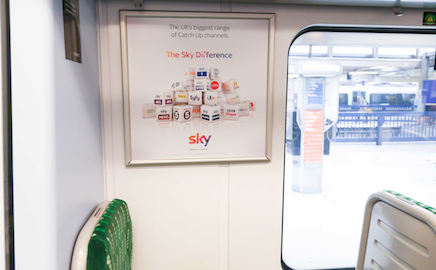Out-of-home (OOH) advertising is undergoing a quiet revolution. Increased connectivity, faster browsing speeds, and wider acceptance of ecommerce, have driven interaction with outdoor ads and brands are seizing these new opportunities.
Last year saw the annual UK OOH spend finally crack the £1 billion barrier and 2015 is showing further growth with brands and marketers developing and maximising the bond between OOH and ecommerce. The link between advertising and purchase planning then making that actual purchase has never been so strong—but where are consumers when they’re shopping online?
A study by mobile payment innovator Zapp revealed that more than a fifth of all UK online shopping sales now take place during a daily commute, accounting for £9.3bn in sales a year. The research also found each commuter spends £36 a week on average rising to £44 for London commuters.
The research polled clothing as the most popular purchase, with almost three quarters of train-using Brits (71%) buying clothes during their weekly train journey. Entertainment and media are also popular, with 68% of commuters paying for digital downloads, and 65% spending on other entertainment such as DVDs, CDs or books.
To delve deeper into the relationship between OOH advertising and ecommerce, we explored what influences consumer behaviour while they are travelling and conducted research into over 2000 rail users to find out more.
The KBH On-Train Media research found that on-train advertising gets noticed. 94% of respondents said they had seen on-train ads, while 48% researched or looked up an advertised product or service. 33% had a conversation about an on-train ad they had seen and 24% made a purchase as a result of the advertising.
Crucially, and unique to ads viewed during rail travel, the average dwell time of 38 minutes on the train gave consumers time to read and absorb and then act on on-train messaging. The dwell time combined with increased connectivity is clearly affecting behaviour. 90% of commuters surveyed were connected to a smart phone on their journey. On average, half the time spent travelling was spent on the device. This connectivity means consumers are able to both research and buy products promoted on the train once they had seen an ad.
There is an opportunity for brands and marketers to capitalise on these changing behaviours by recognising that purchasing decisions depend on the consumer’s mindset and the type of product advertised.
Consumers make both immediate and delayed decisions following exposure to on-train ads. The research found that the most popular time to buy a product or service seen advertised on a train was later that day, with 29% doing so. 28% purchased immediately, while a considerable 27% showed the traincard ads provide advertisers with message longevity, saying they acted on the desire to purchase ‘a few days later’.
Purchase value impacted the speed of action and advertisers should build understanding of this anticipated delay into their campaigns. Big-ticket items tend to be researched and discussed with ‘significant others’, and purchased later. Smaller items, such as fashion, provoked a more immediate response.
The advertiser should also ensure their message fits the commuter’s state of mind in the on-train environment. The train journey acts as a buffer zone between one part of the day and the next and is a time when consumers contemplate the next stage of their day and their wider interests and intentions. Advertisers that build understanding of this state of mind into their campaign will see most success.

For example, Sky Difference launched an effective on-train campaign that recognised the commuter’s contemplative state of mind by prompting ideas for evening and weekend entertainment. Netflix took this idea further with an OOH campaign which delivered content depending on the time of day, weather, and environment and even reacted to news stories and live events.
Savvy marketers are capitalising on the combination of connectivity, dwell time and growth of ecommerce to produce ever more effective campaigns. As a result, advertising has the potential to be more influential on consumer behaviour than ever.
About the Author
Ian Reynolds is Managing Director at KBH On-Train Media, London.
